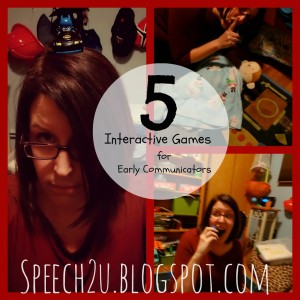If you were making a charm bracelet for a pediatric Speech language pathologist, you’d probably want to include a puzzle piece, a bubble wand and a Mr. Potato head figurine. These are great activities for targeting vocabulary, requesting, early conversation skills and following directions.
What happens when you at the home of a little guy or gal, and they have NO interest in Potato head? Maybe they cry every time you hand over a piece. Or maybe they scream every time you try to touch their toys. You could tell the parents that the child needs to learn to play these games because they are what other children are playing. You could work on teaching visual schedules and first/then and use duration maps to build their tolerance for playing with Mr. Potato Head. Or you could try to get in the zone and change your approach to try to meet their developmental and play needs.
Some children are not ready for toys yet. Some children need to work on basic interactive and give and take skills before they are ready to participate in more advanced games.
Your first step is to remove all toys from the room or your therapy bag. For now, you are going to be the toy. Take a deep breath-it’s okay. Those toys were just tempting you to prompt these kids for something they weren’t ready to do yet.
What are we working on or looking for:
- Shifts in attention
- Increase in babbling engagement imitation.
- Understanding of basic rules or basic give and take types of games.
- Anticipation
A great interactive game/activity tends to follow a pattern. Let’s think about Peek a boo.
1. Starts the Same: Peek a Boo starts with when we place our hands over our eyes.
2. Uses the same language while the child is learning the game (peek-a-boo!)
3. Has a fun or exciting ending: We take our hands off of our eyes and yell “Peek-a-boo!”
The following are 5 of my Favorite Super Silly Games I like to use with these clients:
1. Shhhhh…..they’re sleeping. This is one of my favorite routine games. I try to play it the same each time for the first 3-4 times and then will modify it to get my clients talking. I might start by playing the game with a bear or other favorite character. I lay the bear down, and say “SHHHHH……the bear is sleeping.” This is the start of this game. We whisper because the bear is sleeping. Of course, eventually I forget and talk really loudly. Then I remember I am suppose to start whispering again.
2. Whooops! I ate it. I’ve been known to eat pretty much anything in the speech room cookie monster style. My game starts with “Mmmmmm…..” so they know I am going to eat something. Then I go crazy with “Num, num, num, num” and hide what I just ate behind my back. Usually it’s a toy that they really want. Sometimes we end the game by having the child tell me to “cough” it back up. Hilarity ensues.
3. Shhhhhh……I’m sleeping. Clearly this game is related to “Shhhh….they’re sleeping.” I’m hoping for my client to be loud to wake me up. I can fall asleep anywhere in therapy-usually it is on their arm or leg. This is great for those days when you stayed up late watching television-just be careful not to fall asleep while you are waiting for them to take their turn. That’s actually how I found out I was pregnant. I literally fell asleep for 5-10 seconds during an afternoon speech appointment. I think I suffered from narcoleptic pregnancy.
4. Really? That’s not a hat? Apparently I don’t have a good mental concept of what a hat should look like. I find myself putting objects on my head ALL the time. We work on saying “no” or “not hat.” Sometimes I don’t realize it’s on my head and we work on pointing and the preposition “on.” Sometimes I sneeze and the object “flies” off of my head. We can work on early sound imitation and saying “Bless you.”
5. Pop goes the weasel-I like to do this game on the swing-but a wheely office chair works just as well. This activity starts with have my kid sit on the swing or office chair. We sing, the song while rocking or turning the chair from side to side and then POP! We start spinning really really fast in one direction. It doesn’t really make sense since pop should be going up but that’s the activity that we like to do so that’s what we are doing. Vestibular (spinning) movement can be really powerful input which some children with sensory issues don’t process well. It’s a good idea to check with your OT’s prior to these kind of activities.
These activities are designed to start establishing rapport, early nonverbal turn taking needed for conversation, early imitation, anticipation of other’s actions and early requesting. As the child becomes more familiar with you and these early interaction games, you can start to build in tolerance for other “sit down” activities.


